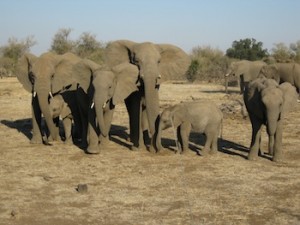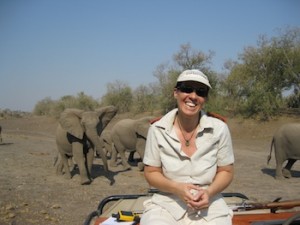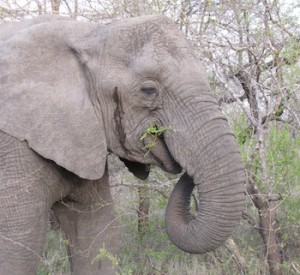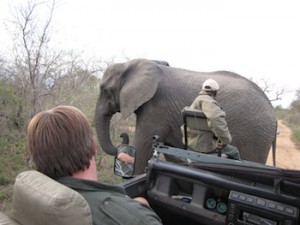
At least 100 elephant are slowly shuffling past our vehicle. They come pouring into the dry riverbed towards us, first appearing over the left bank, then over the right. An elephant traffic jam forms as they filter together, greeting each other, gathering in small social clusters, kicking up dust, then trudging in unison up the dry river. We sit open-mouthed, awed by the immensity of the herd passing within meters of us.
Then one young male tips and tilts his head towards us, flapping his ears menacingly. I suddenly remember that they can see us too, and wonder whether a surge of bravado will see this cocky teenager test his emerging manhood by pounding our vehicle to a pulp. Yet I feel serenely safe, because sitting on the bonnet is Jeanetta Selier, the elephant whisperer.
Jeanetta is beguiling us with stories that turn the previously identical animals into individual characters. The one with the raggedy ear. The one with a broken tusk, damaged in a spectacular turf war. The sad big mama, Segole, who stood guard over the body of her stillborn baby until the other females rumbled softly, telling her it was time to go. She did walk way, but stopped and turned back for one last look before lowering her head and plodding on dejectedly, Jeanetta says. We look again at Segole, whose name means drag foot, because of her deformed back foot. Now we see her as a grieving mother, not as another box to tick on the safari Big Five checklist.

Jeanetta has spent 10 years studying elephant, mainly at Mashatu camp in Botswana. As a scientist she isn’t suppose to do the anthropomorphic thing and give them human names and traits. But she isn’t giving them imaginary personalities, because elephants have oodles of personality of their own. If you watch a herd for a while you soon start to see all the complexities of living in a family, the subtle signs of dominance, affection and belonging, Jeanetta says.
The females and juveniles live in tight-knit matriarchal units while the males live a more solitary existence. The females jointly care for all the young, protecting them from predators and defending their precious resources. Calves are kept close for many years, giving them time to learn essential survival skills. Then as they become rowdy teenagers they’re given the boot, sent off to join an all-male herd or sometimes, to live alone. Elephants are not only renowned for their intelligence, they are also amazing agile, especially considering their sheer bulk. They’re playful too, and Jeanetta has seen babies going down on their heads trying to do a headstand.
Much of the communication between them is still a mystery, although researchers have been able to assign specific meanings to several rumbling sounds. There’s a definite sound they make as an alert to danger, and another for ‘come on, let’s go.’ There are distinct mating calls too, warning the opposite sex that they’re feeling randy!

When an elephant trumpets to its neighbors it’s communicating by sending out low-frequency seismic vibrations. Other elephants pick up the vibrations through their feet and the messages travel up their legs and shoulders by bone conduction to be interpreted by vibration-sensitive receptors in the middle ear. When it detects a seismic call an elephant will freeze, then lean forward to align its front legs with its eardrum. Sometimes they lift a front foot off the ground to pin down the source of the call through triangulation.
These gentle giants have earned a bad reputation in some areas for the amount of damage they do, stripping trees bare for their bark or upending them to nibble the tasty roots.
Ranger Floris de Meyer of Tangala safari camp reckons elephants are given a bad rap needlessly. They’re not a wrecking crew, he says, just enthusiastic landscape gardeners whose efforts leave plenty of room for new trees and shrubs to grow.
Tangala is a private camp bordering the Kruger National Park in South Africa, and has about 60 elephant. One morning we watch for ages as two elephants methodically devour branch after branch of a clearly delicious tree. It’s a comical show, as they gracefully curl up their trunks to feed and flutter those gorgeous eyelashes.

When they’ve had their fill they amble past our vehicle, so close that I could shake hands with their inquisitive trunks.
Sadly, some people are only interested in elephant for their ivory, and poaching is on the increase. A scary estimation from the International Union for Conservation of Nature (IUCN) is that one elephant is killed every 15 minutes. A century ago there were 10 million African elephants, and now there are only about 400,000. Ivory poachers are often part of organized networks, and far better armed than the rangers trying to stop them. The IUCN says poaching has doubled in the last decade, and at the rate they’re being killed, wild elephant will be extinct within 50 years.
The best places to see elephant:
Most safari lodges in Southern Africa are in elephant territory, but Mashatu Game Reserve in eastern Botswana has particularly large herds. Mashatu Main Lodge has 14 luxury suites that look out over the waterhole, while the Tent Camp has private, spacious and comfortable tents on concrete platforms with en-suite facilities including an open-air shower. Details from http://www.mashatu.com
Tangala Bush Camp in South Africa is a three-star lodge offering five-star game viewing. It’s a more authentic safari experience than the upmarket lodges – and far cheaper – with no electricity but comfortable en-suite rooms and meals cooked by gas or over the camp fire. Details from http://www.tangalathornybush.co.za


